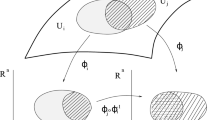Abstract
A survey is given of the concepts of interaction (force) and matter, i.e., of process and substance. The development of these concepts, first in antiquity, then in early modern times, and finally in the contemporary system of quantum field theory is described. After a summary of the basic phenomenological attributes (coupling strengths, symmetry quantities, charges), the common ground of concepts of quantum field theory for both interactions and matter entities is discussed. Then attention is focused on the gauge principle which has been developed to describe all interaction fields in the same way, and hopefully to unite them all into one unified field. While a similar unification of all fundamental types of matter fields (quarks and leptons) into one family may be possible (SU 5), there still remains at this level a duality between interaction quanta (bosons with spin 1) and matter particles (fermions with spin 1/2). Whether this duality may be removed in some future “supersymmetric” theory is not discussed in this paper. Nor is Quantum Gravitation discussed, though the analogy of the gauge principle for the three fundamental non-gravitational interactions (hadronic, electromagnetic and weak) to Einstein's principle of equivalence for gravitation in spacetime is noted. However, the equivalence concept is applied not to spacetime but to the internal spaces for the matter (or “charge”) fields which are the sources between which the fundamental interactions operate. The gauge principle states that a change in the measures of the internal space charge of “gauge” or “phases” of the matter fields is equivalent to, and can be compensated by, suitably introduced interaction fields. From such an interaction field, the gauge potential field in the internal space, one may derive a gauge force field by exterior differentiation.
Geometrically, the collection of all internal spaces, one over each point of spacetime, constitutes a “fiber bundle”. The gauge potential field represents a “connection” on the fiber bundle, and the gauge force field is the “curvature” (calculated by taking the exterior derivative of the connection and adding to it the exterior product of the connection with itself). Thus, just as gravitational force is interpreted as spacetime curvature, so the three other fundamental forces are interpretable as internal space curvature. The Standard Model which unites the three non-gravitational fields into an SU 3 c ×SU 2×U 1 structure, and the grand unified model, SU 5, are discussed briefly, and difficulties are noted. Finally it is suggested that a composite model, based on more subtle structure, may be needed to remove the present obscurities and difficulties that stand in the way of a unified theory.
Similar content being viewed by others
Author information
Authors and Affiliations
Rights and permissions
About this article
Cite this article
Melvin, M.A. Towards unified field theory: Quantitative differences and qualitative sameness. Synthese 50, 359–397 (1982). https://doi.org/10.1007/BF00413889
Issue Date:
DOI: https://doi.org/10.1007/BF00413889




